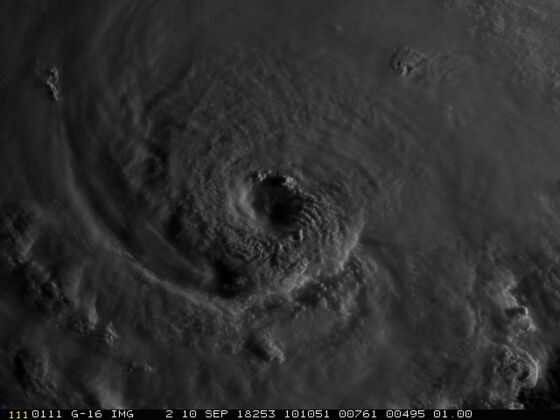Florence Aims for U.S. East Coast as 1 Million Told to Leave
Hurricane Florence’s top winds exploded to 209 kilometers per hour, making it a Category 4 storm as it nears the U.S east coast.

(Bloomberg) -- Florence continued to roll toward the U.S. East Coast, poised to become the strongest hurricane in almost 30 years to hit the Carolinas as more than 1 million people began fleeing a coastline that could see a 12-foot storm surge.
North Carolina’s Outer Banks are under mandatory evacuation orders and four states declared emergencies as the Category 4 storm barreled toward the coast. Already estimated to bring as much as $27 billion in damages, Florence is aiming for landfall late Thursday or early Friday somewhere between Charleston, South Carolina and Norfolk, Virginia.

Hurricane and storm surge watches were issued for sections of the coastlines of North Carolina and South Carolina with a storm surge expected to reach as much as 12 feet above ground in some areas. If it comes ashore in the region, the hurricane will be the most powerful storm since Hugo slammed into South Carolina in 1989.
“Florence is going to be an extremely dangerous major hurricane,’’ said Jeff Masters, co-founder of Weather Underground in Ann Arbor, Michigan. “It will bring extreme wind damage and surge damage.’’

The storm’s top speeds reached 140 miles (220 kilometers) per hour, the U.S. National Hurricane Center said in an update at 5 a.m. New York time. It’s currently 410 miles southeast of Bermuda. Category 4 is one level below the most severe storm, and the center warned that Florence would remain an “extremely dangerous major hurricane through Thursday night.”
The hurricane’s effects are already being felt in markets, with shares of home-improvement retailers Lowe’s Cos. and Home Depot Inc. rising alongside the price of hogs and cotton. Insurance companies fell as the storm’s power and path became clearer.
To see a map of storms in the region, click here

President Donald Trump on Monday night declared an emergency in North Carolina. That authorizes the Department of Homeland Security and the Federal Emergency Management Agency “to coordinate all disaster relief efforts,” the White House said in a statement.
The president is scheduled to receive in-person briefings from the heads of the Department of Homeland Security and the Federal Emergency Management Agency on Tuesday, following phone conversations Monday, White House Press Secretary Sarah Sanders said during a briefing. The White House has been in touch with the governors of several threatened states, she said.
"Lines of communication remain open and the federal government stands ready to assist," Sanders said.

Sent via Twitter for iPhone.
View original tweet.
More than 750,000 homes in North Carolina, South Carolina and Virginia with a reconstruction cost value of about $170.2 billion are at potential risk of storm surge damage from Florence based on its Category 4 status, according to CoreLogic, a property analytics firm in Irvine, California.
| More storm coverage: |
|---|
| Florence will flirt with Category 5 strength Carolinas face days, weeks, with no power Catastrophe bonds in crosshairs U.S. Southeast gas demand may be cut Watch the orange blob following Harvey’s path Risks include toxic sludge and lagoons of pig manure |
Some forecasts call for Florence to stall out after it strikes the coast. That would mean more flooding rains across a large part of the U.S. South, expanding the damage, according to Chuck Watson, a disaster modeler with Enki Research in Savannah, Georgia.
“The big problem is they are now talking about taking hurricane-force winds in as far as the Research Triangle,’’ Watson said, referring to the Raleigh-Durham-Chapel Hill area. “Pine trees tend to fracture at 70 miles per hour. That pine tree is going to wind up somewhere, maybe in someone’s living room.’’
The storm has spurred a broad range of reactions:
- The governors of South Carolina, North Carolina, Maryland and Virginia have declared emergencies.
- Power companies warned residents may be without power for days or weeks.
- Volvo Car Group is shutting its factory in South Carolina because of the storm.
- Natural gas demand in the U.S. Southeast may be cut by as much as half.
- Ports in the region are stowing empty containers and preparing to shift to generator power if needed for refrigeration.
- The Port of Virginia will halt terminal activities at 11:59 p.m. on Tuesday, with all vessels departing the port’s berths.
- Hog and poultry companies are filling feed bins, checking generators and stocking up on fuel supplies.
- Further east, forecasters are watching hurricanes Helene, which will probably head into the open Atlantic, Isaac and a patch of showers in the western Caribbean, which has a 60 percent chance of becoming a cyclone in the next 5 days.
--With assistance from Pratish Narayanan, Chris Dolmetsch, Alex Longley, Simon Casey, Esha Dey, Janet Freund, Naureen S. Malik, Mario Parker, Megan Durisin, Shruti Date Singh, Samuel Robinson, Christopher Martin, Jim Efstathiou Jr., Ari Natter, John Harney and Heesu Lee.
To contact the reporter on this story: Brian K. Sullivan in Boston at bsullivan10@bloomberg.net
To contact the editors responsible for this story: Joe Ryan at jryan173@bloomberg.net, Brian Wingfield, John Deane
©2018 Bloomberg L.P.